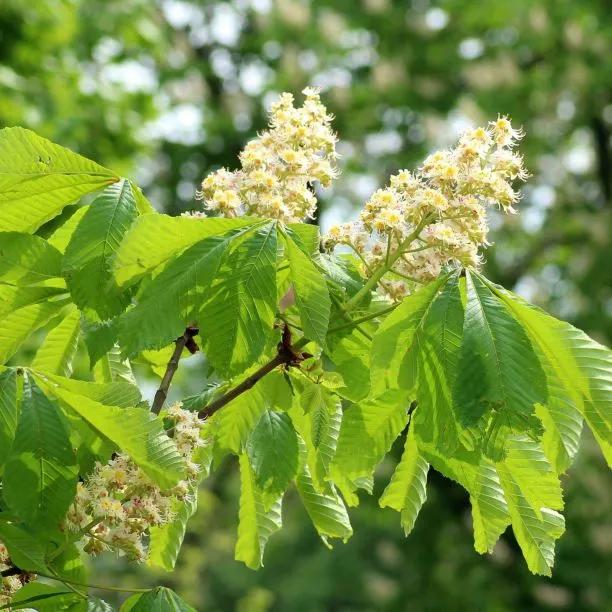Horse Chestnut, Large Trees
The details
- Large, spreading.
- Produces white flowers & conkers.
- Any well drained soil.
- Sizes: Big Standards & Young Saplings
- Max Height 35 metres.
- Bareroot Delivery: Nov-Mar
Recommended extras
Description
Aesculus hippocastanum: Bareroot Conker Trees in Standard Sizes
Everyone knows the Common Horse Chestnut or Conker tree, Aesculus hippocastanum, with its lovely big spires of pink-eyed, white flowers that cover the tree in early summer. It has big, deep green, lobed leaves that remind me of a splayed (giant) gecko's foot and turn a dirty, rustic amber colour in Autumn.
Large and spreading, suitable only for parks and big gardens, they can reach a height of about 30-35 metres and spread up to 25 metres across.
Browse our variety of large trees for your garden or view our full range of trees.
You can also buy younger horse chestnut saplings.
Delivery season: Horse Chestnut trees are delivered bareroot during late autumn and winter, approximately November-March inclusive.
Choosing a size: Small trees are cheaper, easier to handle and more forgiving of less than ideal aftercare, so they are best for a big planting project. If instant impact is your priority, or if you are only buying a few plants for use in a place where it is convenient to water them well in their first year, then you may as well use bigger ones. All our bareroot trees are measured by their height in centimetres above the ground (the roots aren't measured).
Features:
- Height: To 30-35m
- Soil: Any well drained
- Use: Large gardens, parkland, wide avenue, urban
- Lovely big panicles of white flowers in May-June
- Spiky green seed cases
- Bareroot delivery only: November-March
Growing Horse Chestnut Trees
Any well drained soil, tolerates temporary flooding in winter. Full sun or partial shade. Young trees can manage in deeper shade as long as they grow up into sunnier conditions. Tolerant of pollution.
Horse Chestnuts suffer from two unsightly but fairly harmless leaf problems, one caused by a fungus, the other by a leaf mining insect, that cause the leaves to turn brown in late summer. The treatment for both is the same: rake up all the leaves in Autumn and get rid of them!
Planting Instructions
Notes on planting Common Horse Chestnut trees:
Horse Chestnuts are big trees with powerful roots; we recommend planting them at least 30 metres away from buildings. They will grow in any soil, including chalk, and young trees tolerate shade well. They are very hardy and mature trees are tough as anything, tolerating soggy winters followed by scorching summers without any set-back.
Prepare your site before planting:
It is good to dig over the site where you plant a tree several months in advance. Kill the weeds first: for tough weeds like nettles, brambles and ground elder, you will usually need weed-killer to get rid of them. When you dig the soil over, remove stones and other rubbish and mix in well-rotted compost or manure down to the depth of about 2 spades.
Watch our video on how to plant a tree for full instructions.
Remember to water establishing trees during dry weather for at least a year after planting.
Tree Planting accessories:
Prepare your site for planting by killing the weeds and grass.
You can buy a tree planting pack with a wooden stake & rubber tie to support the tree and a mulch mat with pegs to protect the soil around the base of your tree from weeds and drying out.
We suggest that you use mycorrhizal "friendly fungi" on the roots of all newly planted large trees: if your soil quality is poor, we strongly recommend it.
Did You Know?
Hippo-castanum means horse chestnut. A hippo-potamus is a "horse of the water". Despite the name, the beautifully shiny and smooth seed that pops out of the spiky green husks is poisonous to horses, and most large animals.
Like a number of trees that we consider to be native to Britain, they are in fact relatively new introductions. Their strict native range is the Balkans and the Pindus mountain range in Greece and Albania, but they are found across most of South Eastern Europe, Turkey, and the Middle East as far as the Western Himalayas.
The Viennese began growing this tree in the 1570's, and they probably arrived here in the early 1600's, naturalising with great success. They are relatively short-lived for such a large tree, lasting for only 150-200 years in most cases, 300 at most.
Bavarian beer gardens and conker trees go together like fish and fingers. The tradition dates back to the days when lager was brewed in caverns and dug outs to keep it cool. Horse chestnuts cast dense shade and have shallow, spreading roots, so they are ideal for planting on top of your beer cave to keep the sun off it.
Standard trees are measured by their girth in centimetres 1 metre above ground level: their trunk's waist measurement. Unlike sapling trees and hedge plants, standards aren't measured by their height, which will vary quite a bit both between and within species.
So, a 6/8cm standard tree has a trunk with a circumference of 6-8cm and an 8/10 standard has a trunk 8-10cm around. This measurement makes no difference to the tree's final height.
On average, standard trees are 2-3.5 metres tall when they arrive, but we cannot tell you precisely how tall your trees will be before we deliver them.


